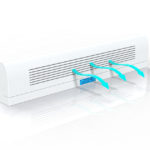 Indoor air quality (IAQ) is a big concern for many homeowners. In high-density urban areas with poor outdoor air quality, the Environmental Protection Agency (EPA) recommends staying indoors and breathing conditioned air. So it’s now more important than ever that residential HVAC systems meet the highest standards in IAQ protection.
Indoor air quality (IAQ) is a big concern for many homeowners. In high-density urban areas with poor outdoor air quality, the Environmental Protection Agency (EPA) recommends staying indoors and breathing conditioned air. So it’s now more important than ever that residential HVAC systems meet the highest standards in IAQ protection.
As their HVAC technician, you do a lot to make that happen. You keep their system balanced and running smoothly; you ensure their filters are replaced regularly and their ducts are clean. You install high-quality wall caps and vents that protect the building envelopes in their homes, helping them avoid moisture and mold issues.
While you can’t be there all the time to monitor their IAQ, you can help them choose a product that will. Following is a sampling of the products that are being marketed to your customers.
Olfinity claims to be the first ever “intelligent indoor air system.” It’s made up of a network of air purifiers, air quality monitors, and aromatherapy diffusers. The system is controlled with an app that can be installed on a smartphone or tablet.
The air monitor can be used indoors or outdoors and detects:
• volatile organic compounds (VOCs)
• particulate matter (PM)
• humidity
• temperature
The aromatherapy diffuser is perhaps the most interesting feature of the Olfinity system. The company acknowledges that the essential oils used in aromatherapy are themselves VOCs. The diffuser uses eight patented aromatherapy blends and releases them into the air in what the company calls an “optimized dosage.”
Air Mentor offers all the same features as the Olfinity monitor, with some minor differences in ranges. The app uses Bluetooth and includes:
• a sensor
• a bridge devise for communication between the sensor and the cloud
• a media player that sends air quality data to a signage screen for display
• air cloud manager, an app that allows you to access reports and data on air quality
Air Mentor provides only air quality information. This system looks like a good option for a small office or other workplace where staff wants to see air quality information.
Another IAQ app on the market is Awair. It’s a single device that monitors air quality and provides information via a smart home app. There are three models available: Awair, Awair Baby, and Awair Glow.
Awair Glow has a monitor that includes a power outlet. Your customers can plug an air quality improvement appliance like a dehumidifier or air purifier into the outlet. The Glow system will power on the appliance when it detects a need for it. This is a good option for your customers who have not adopted other smart home technology.
Awair and Awair Baby are air monitors that communicate with other smart home devices such as Nest thermostats.
This app is simpler and only reports the following:
• temperature
• humidity
• carbon dioxide (CO2)
• chemicals
• dust
The app uses a color-coded system to give customers a general rating of the air quality, and it provides feedback about specific issues. For example, the app will indicate when the air quality is likely to trigger an eczema flare-up.
The Netatmo weather station is another app that simplifies the language around air quality. It has only an “air quality” measure, so it doesn’t distinguish between chemicals and dust. It seems to use CO2 levels to indicate the quality of ventilation. The Netatmo also measures one home comfort feature that none of the other devices handle: noise levels. This measure can be used to help residents that deal with sleep issues.
The Natatmo has both indoor and outdoor monitoring devices, and can communicate with Amazon Echo.
While all of these products offer slightly different features, they all provide your customers with a sense of control over their environment. They also reinforce the importance of the work you do in protecting their IAQ.



